数据结构实验7:实现二分查找、二叉排序(查找)树和AVL树
实验7
学号: 姓名: 专业:
7.1实验目的
(1) 掌握顺序表的查找方法,尤其是二分查找方法。
(2) 掌握二叉排序树的建立及查找。
查找是软件设计中的最常用的运算,查找所涉及到的表结构的不同决定了查找的方法及其性能。二分查找是顺序表的查找中的最重要的方法,应能充分理解其实现方法和有关性能,并能借助其判定树结构来加深理解。二叉排序树结构在实验时具有一定的难度,可结合二叉树的有关内容和方法来实现。
7.2 实验任务
编写算法实现下列问题的求解。
(1) 对下列数据表,分别采用二分查找算法实现查找,给出查找过程依次所比较的元素(的下标),并以二分查找的判定树来解释。
第一组测试数据:
数据表为 (1,2,3,4,6,7,8,9,10,11,12,13,17,18,19,20,24,25,26,30,35,40,45,50,100)
查找的元素分别为: 2,8,20, 30,50,5,15,33,110
第二组数据:
数据表为 (2,3,5,7,8,10,12,15,18,20,22,25,30,35,40,45,50,55,60, 80,100)
查找的元素分别为: 22,8,80,3,100,1,13,120
(2) 设计出在二叉排序树中插入结点的算法,在此基础上实现构建二叉排序树的算法。
测试数据:构建二叉排序树的输入序列如下:
第一组数据:
100,150,120,50,70,60,80,170,180,160,110,30,40,35,175
第二组数据:
100,70,60,80,150,120,50,160,30,40,170,180,175,35
(3) 设计算法在二叉排序树中查找指定值的结点。
测试数据:在任务<1>中第一组测试数据所构造的二叉排序树中,分别查找下列元素: 150,70,160,190,10,55,175
(4) 设计算法在二叉排序树中删除特定值的结点。
测试数据:在任务(1)中第一组测试数据所构造的二叉排序树中,分别删除下列元素:30,150,100
(5) 已知整型数组A[1..26]递增有序,设计算法以构造一棵平衡的二叉排序树来存放该数组中的所有元素。
测试数据:数组元素分别为:
第一组数据:
(1,2,3,4,5,6,7,8,9,10,11,12,13,14,15,16,17,18,19,20,21,22,23,24,25,26)
第二组数据:
(1,3,6,10,15,21,28,36,45,55,66,78,91,105,120,136,153,171,190,210,231,253,277,302,328)
7.3实验数据要求
自我编写测试样例,要求每个功能函数的测试样例不少于两组
7.4 运行结果截图及说明
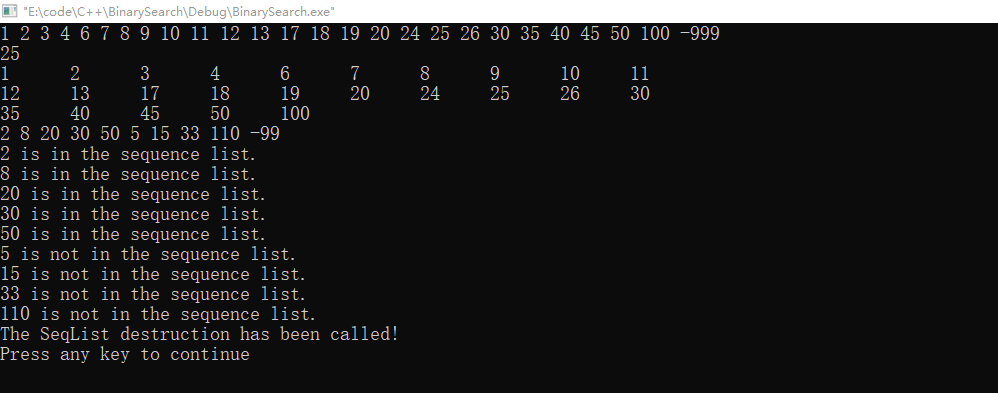
图1 测试(1)①

图2 测试(1)②
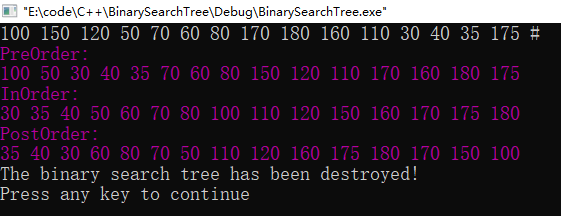
图3 测试(2)①
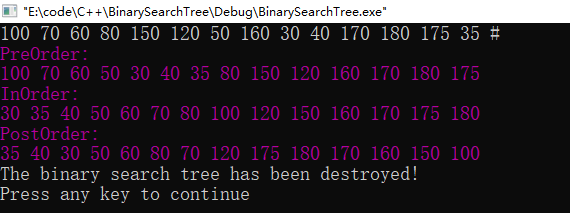
图4 测试(2)②
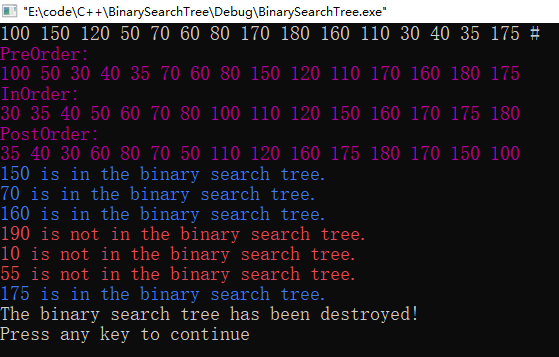
图5 测试(3)
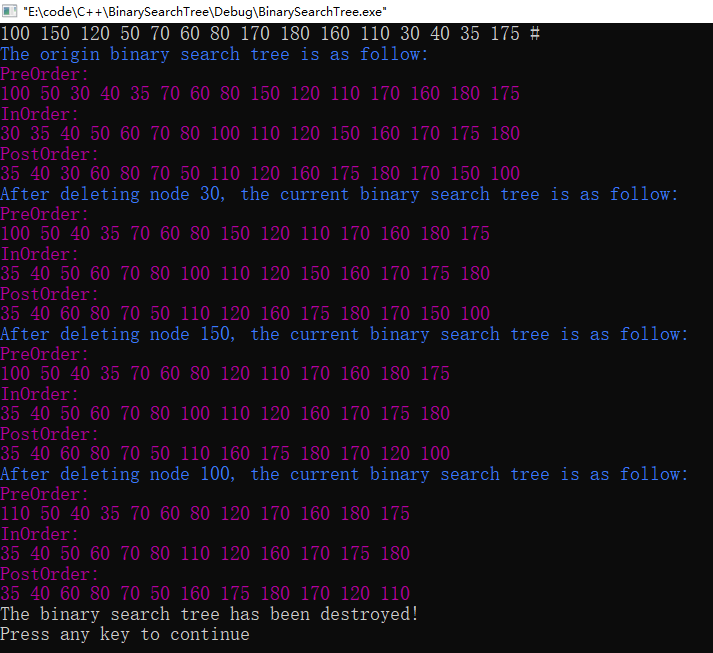
图6 测试(4)
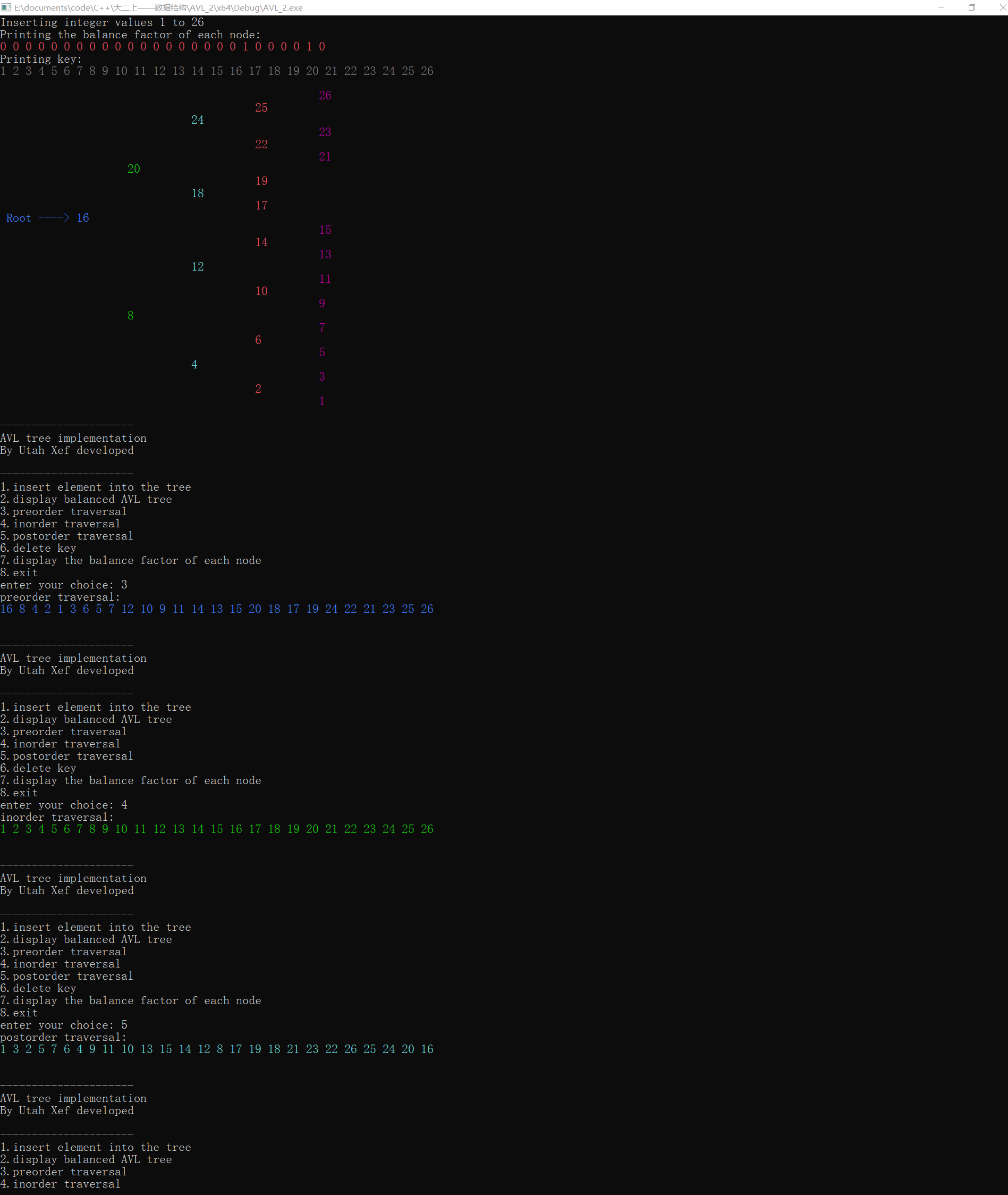
图7 测试(5)①
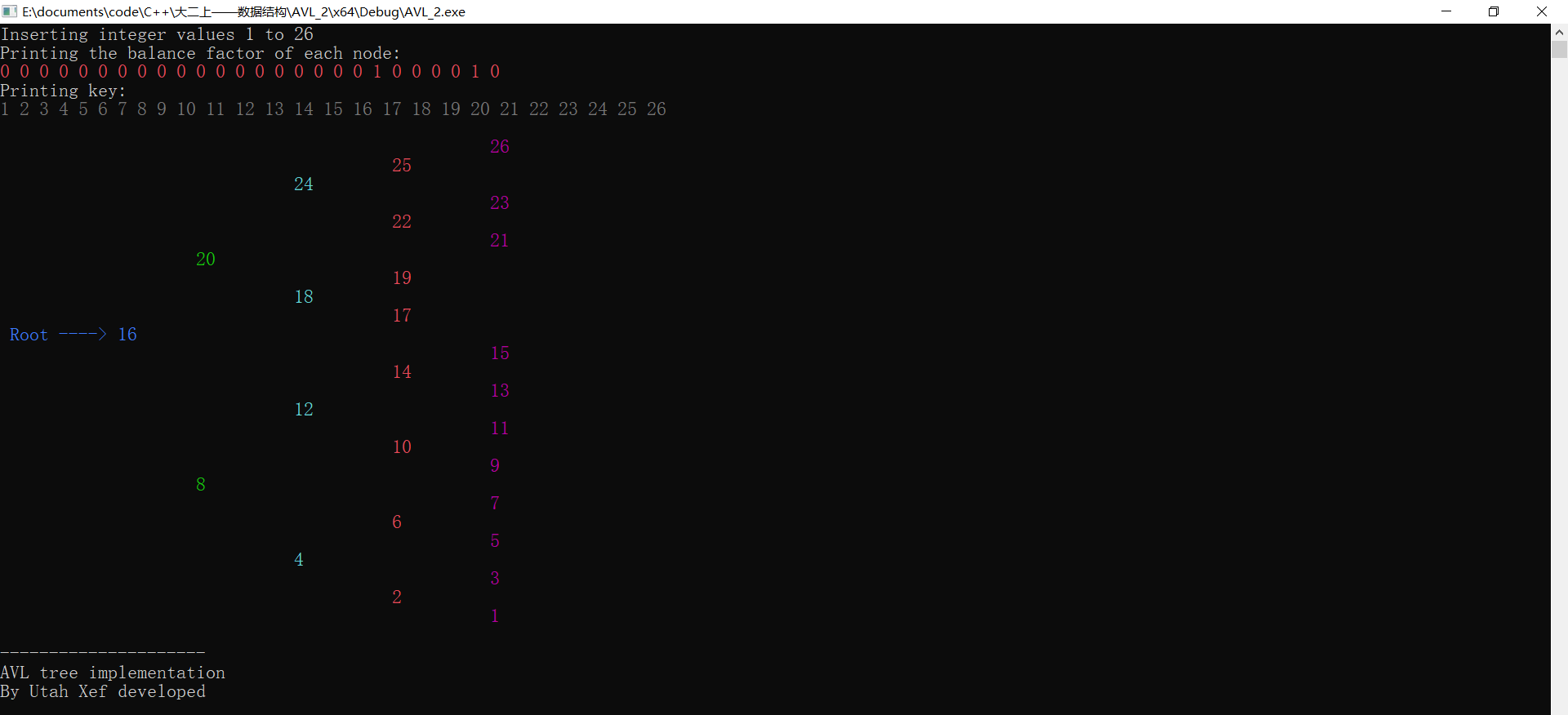
图8 测试(5)①
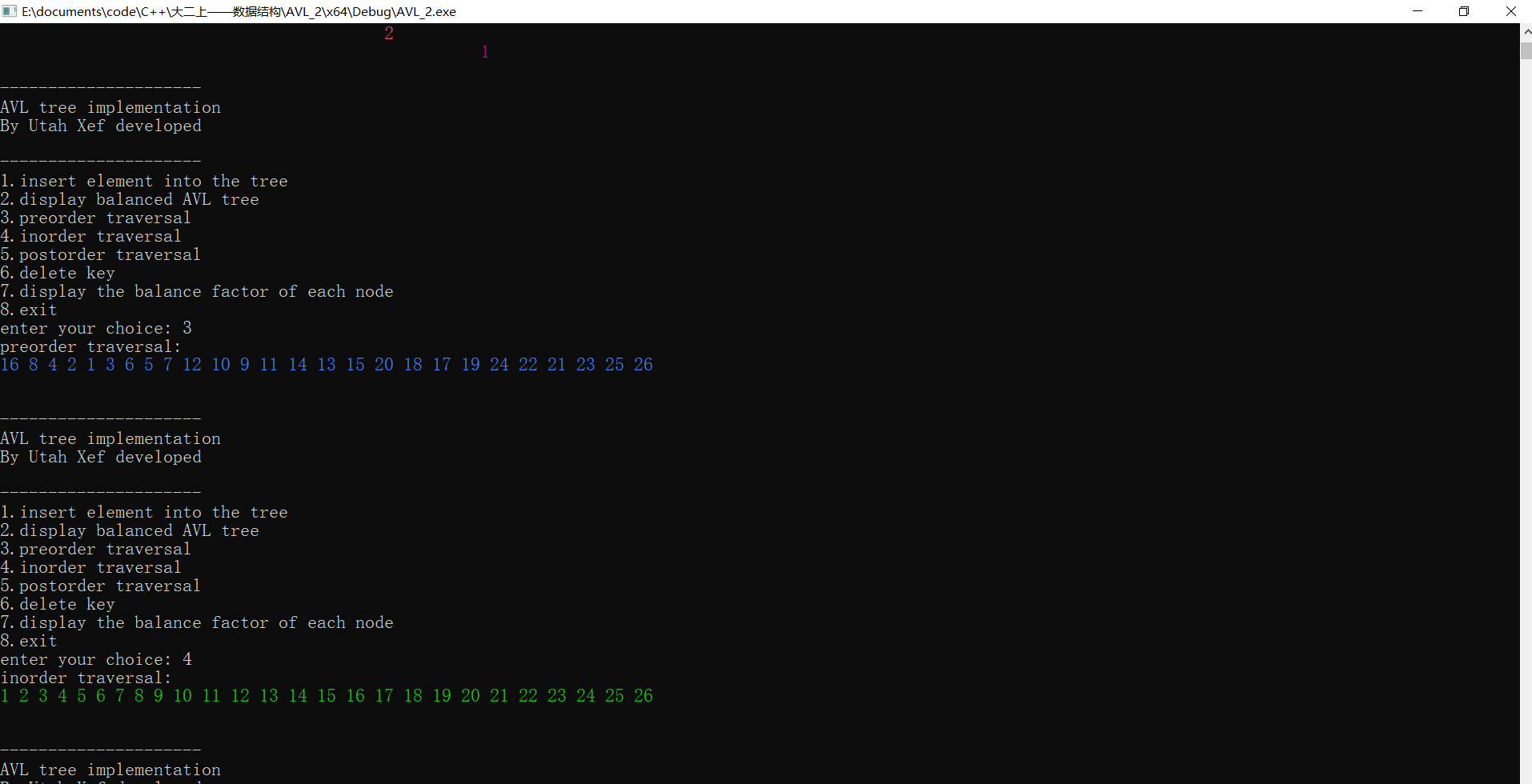
图9 测试(5)①
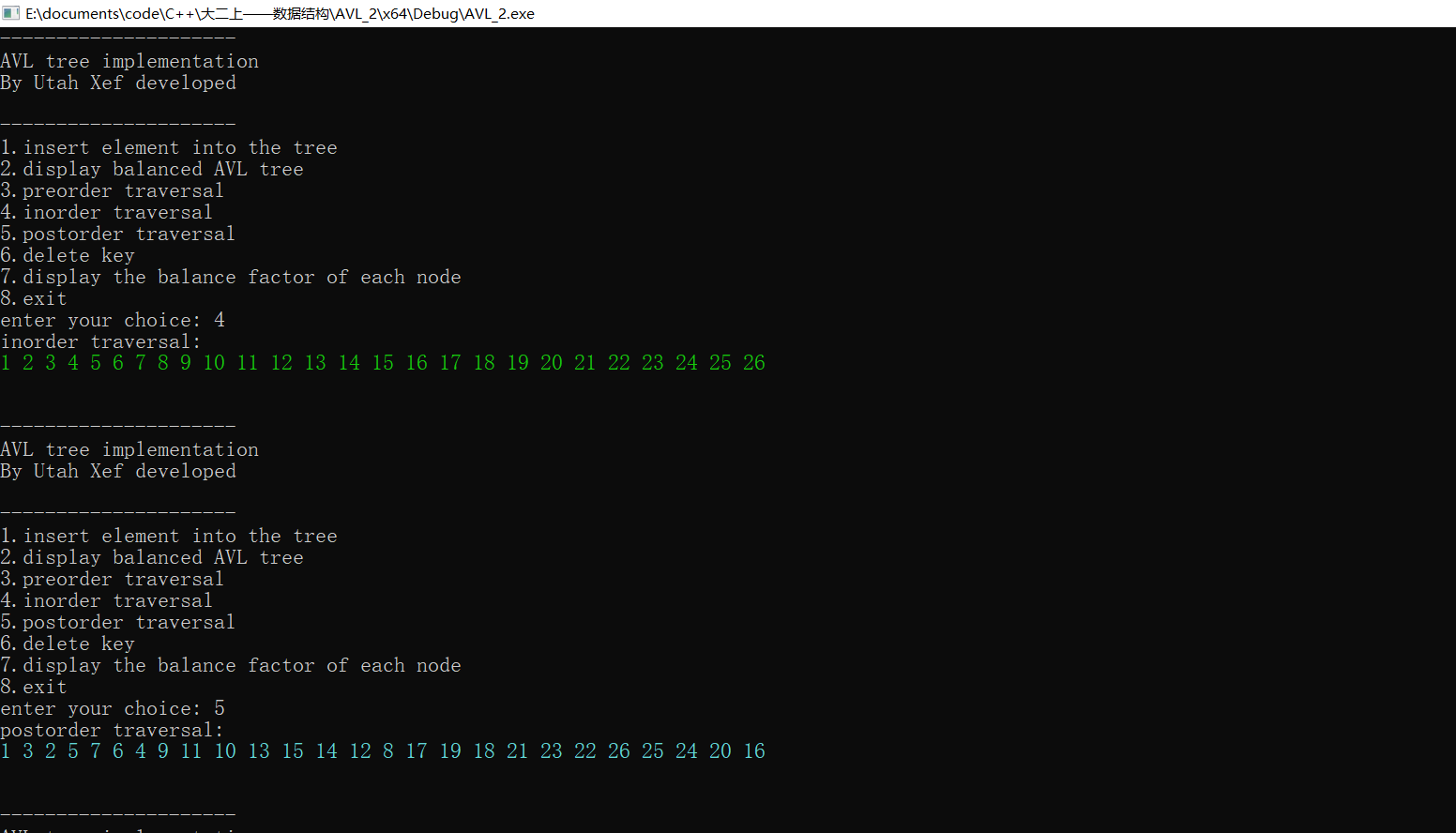
图10 测试(5)①
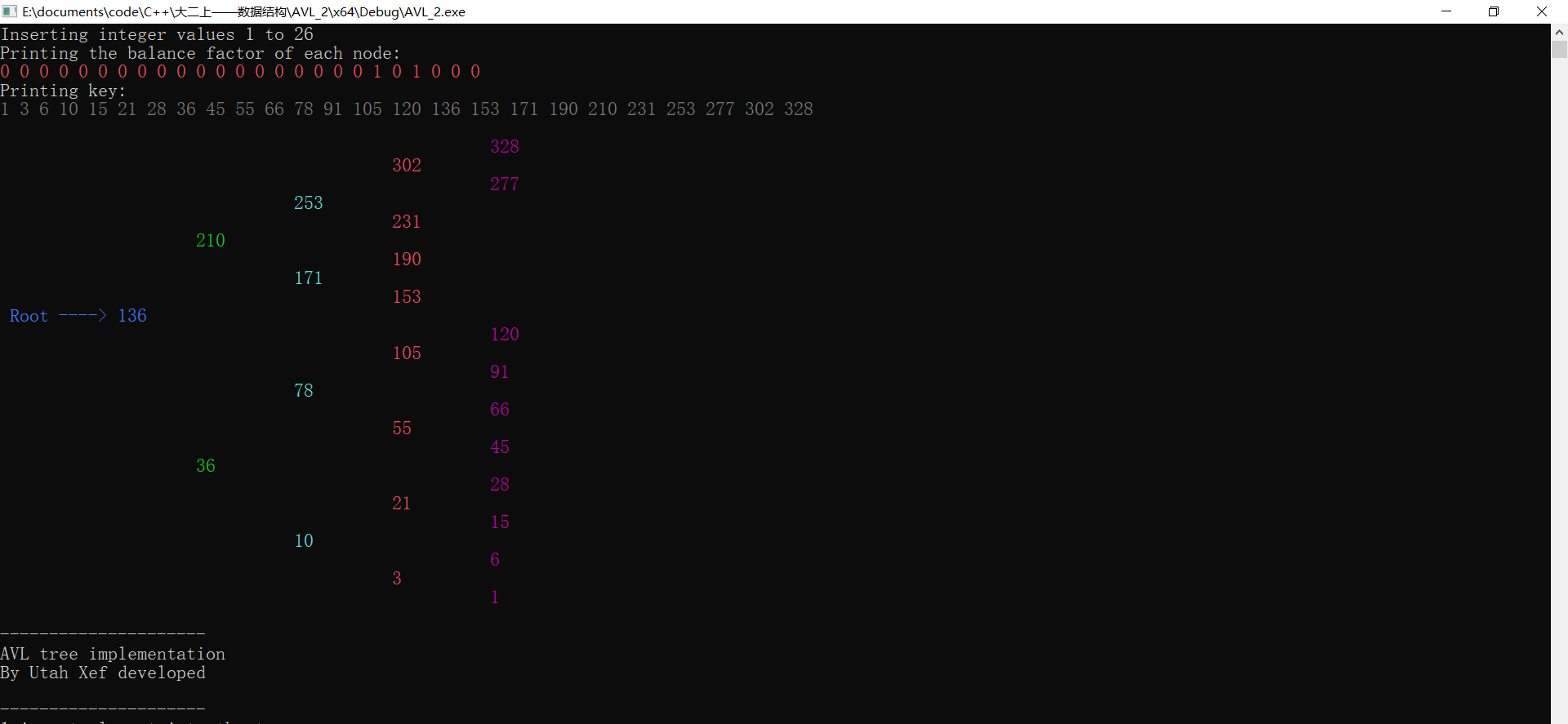
图11 测试(5)②
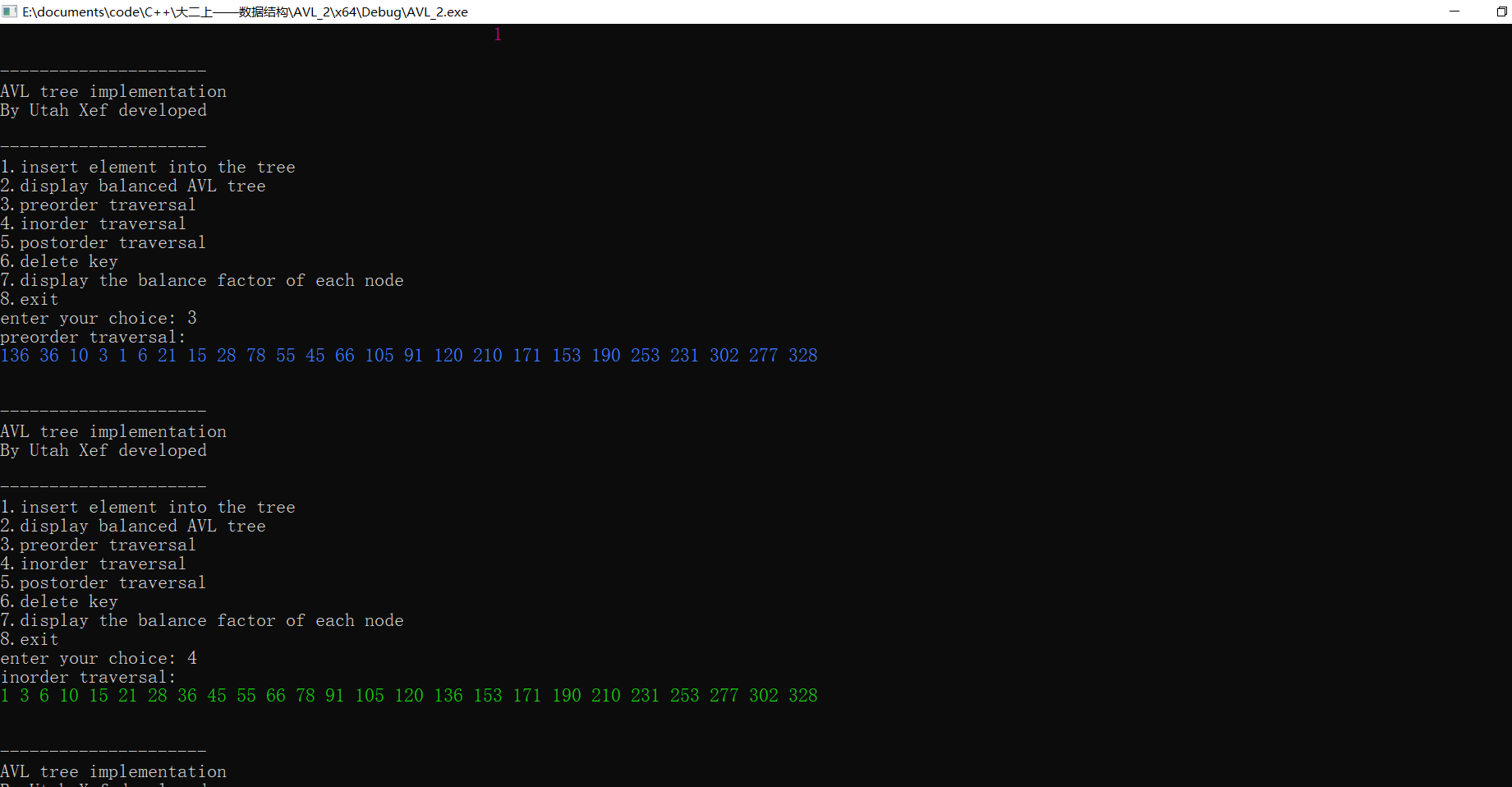
图12 测试(5)②
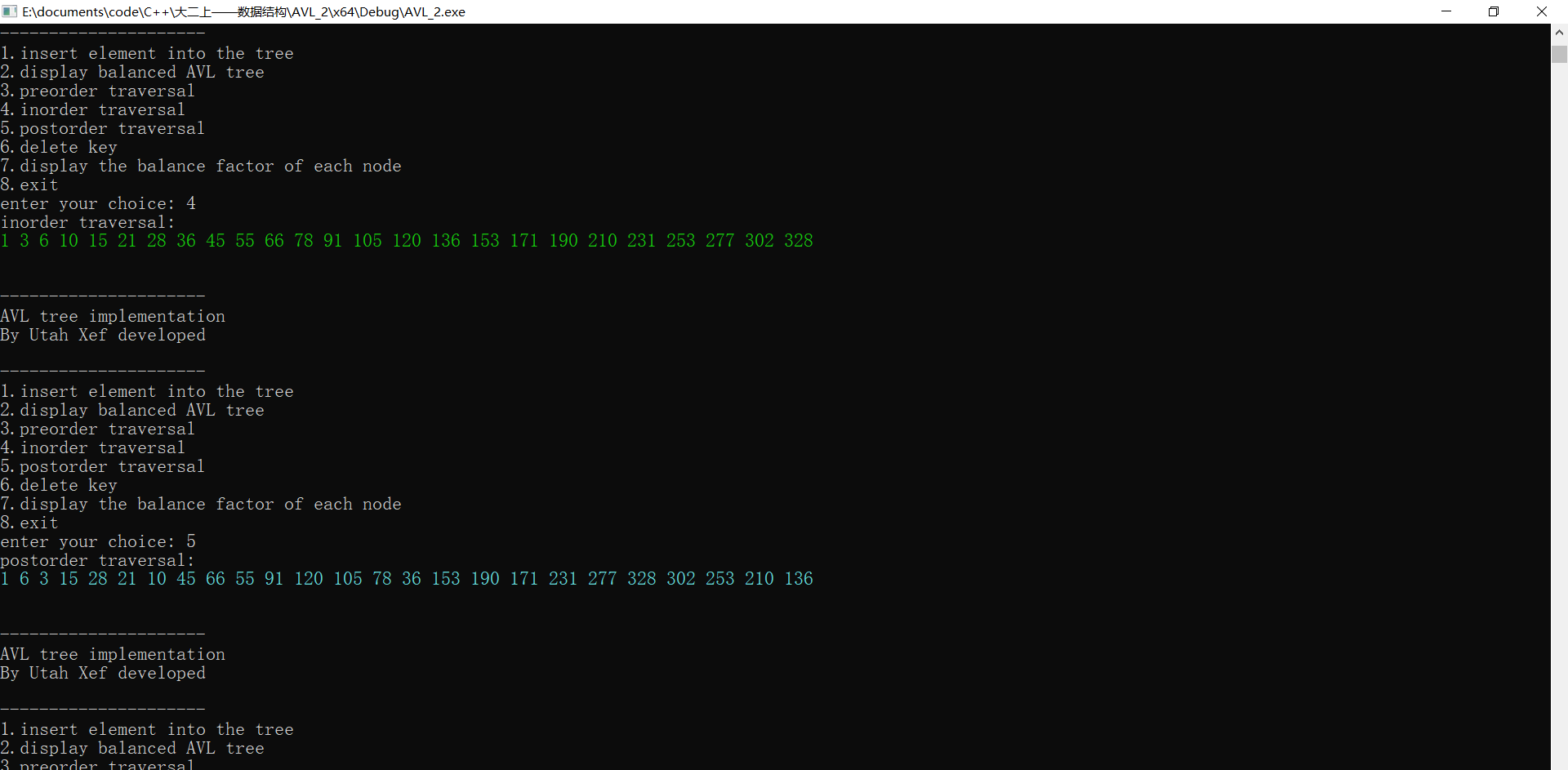
图13 测试(5)②

图14 测试(5)①(全)

图15 测试(5)②(全)
7.5 附源代码
二分查找:
- // stdafx.h : include file for standard system include files,
- // or project specific include files that are used frequently, but
- // are changed infrequently
- //
- #if !defined(AFX_STDAFX_H__940FF418_5647_412A_8B4F_3C89C07F8CA5__INCLUDED_)
- #define AFX_STDAFX_H__940FF418_5647_412A_8B4F_3C89C07F8CA5__INCLUDED_
- #if _MSC_VER > 1000
- #pragma once
- #endif // _MSC_VER > 1000
- #include <stdc++.h>
- using namespace std;
- typedef long elementType;
- const long maxn = + ;
- // TODO: reference additional headers your program requires here
- //{{AFX_INSERT_LOCATION}}
- // Microsoft Visual C++ will insert additional declarations immediately before the previous line.
- #endif // !defined(AFX_STDAFX_H__940FF418_5647_412A_8B4F_3C89C07F8CA5__INCLUDED_)
- // SeqList.h: interface for the SeqList class.
- //
- //////////////////////////////////////////////////////////////////////
- #if !defined(AFX_SEQLIST_H__58D90762_85EC_4BBB_94EA_068A582CCD81__INCLUDED_)
- #define AFX_SEQLIST_H__58D90762_85EC_4BBB_94EA_068A582CCD81__INCLUDED_
- #if _MSC_VER > 1000
- #pragma once
- #endif // _MSC_VER > 1000
- class SeqList
- {
- public:
- SeqList();
- virtual ~SeqList();
- bool seqListFull();
- bool seqListEmpty();
- void randomInsert( elementType number );
- void insert( elementType value );
- void showLength();
- elementType binarySearch( elementType value );
- friend ostream &operator<<( ostream &os, SeqList &SL )
- {
- if( SL.length == - )
- {
- return os;
- }
- int column = ;
- for( int i = ; i <= SL.length; i ++ )
- {
- os << setw() << setiosflags( ios::left ) << SL.Arr[i] << " ";
- column ++;
- if( column % == )
- os << endl;
- }
- os << endl;
- }
- private:
- elementType Arr[maxn];
- int length;
- };
- #endif // !defined(AFX_SEQLIST_H__58D90762_85EC_4BBB_94EA_068A582CCD81__INCLUDED_)
- // SeqList.cpp: implementation of the SeqList class.
- //
- //////////////////////////////////////////////////////////////////////
- #include "stdafx.h"
- #include "SeqList.h"
- //////////////////////////////////////////////////////////////////////
- // Construction/Destruction
- //////////////////////////////////////////////////////////////////////
- SeqList::SeqList()
- {
- length = ;
- }
- SeqList::~SeqList()
- {
- ios::sync_with_stdio(false);
- cout << "The SeqList destruction has been called!" << endl;
- }
- bool SeqList::seqListFull()
- {
- return length == maxn - ;
- }
- bool SeqList::seqListEmpty()
- {
- return length == ;
- }
- void SeqList::randomInsert( elementType number )
- {
- ios::sync_with_stdio(false);
- if( seqListFull() )
- {
- cerr << "Inserting failed!The sequence list has been full.Error in void SeqList::randomInsert( int number )" << endl;
- return;
- }
- srand( time(NULL) );
- elementType last = -;
- for( int i = ; i < number; i ++ )
- {
- elementType key = rand() % ( - + ) + ;
- if( key >= last )
- {
- length ++;
- Arr[length] = key;
- last = key;
- }
- else
- {
- i --;
- }
- }
- }
- void SeqList::insert( elementType value )
- {
- ios::sync_with_stdio(false);
- if( seqListFull() )
- {
- cerr << "Inerting failed!The sequence list has been full.Error in void SeqList::insert( elementType value )" << endl;
- return;
- }
- length ++;
- Arr[length] = value;
- }
- elementType SeqList::binarySearch( elementType value )
- {
- ios::sync_with_stdio(false);
- if( seqListEmpty() )
- {
- cerr << "Searching failed!The sequence list is empty.Error in elementType SeqList::binarySearch( elementType value )" << endl;
- return -;
- }
- elementType lower = , upper = length;
- while( lower <= upper )
- {
- elementType mid = ( lower + upper ) >> ; //+ 1;
- if( Arr[mid] == value )
- {
- return mid;
- }
- if( Arr[mid] >= value )
- {
- upper = mid - ;
- }
- else
- {
- lower = mid + ;
- }
- }
- return -;
- }
- void SeqList::showLength()
- {
- ios::sync_with_stdio(false);
- cout << length << endl;
- }
- // BinarySearch.cpp : Defines the entry point for the console application.
- //
- #include "stdafx.h"
- #include "SeqList.h"
- void test1()
- {
- ios::sync_with_stdio(false);
- SeqList SL1;
- elementType number;
- cin >> number;
- SL1.randomInsert( number );
- cout << SL1;
- elementType value;
- for( int i = ; i < number; i ++ )
- {
- cin >> value;
- if( SL1.binarySearch(value) != - )
- {
- cout << value << " is in the sequence list." << endl;
- }
- else
- {
- cout << value << " is not in the sequence list." << endl;
- }
- }
- }
- void test2()
- {
- ios::sync_with_stdio(false);
- SeqList SL1;
- elementType value;
- while( cin >> value )
- {
- if( value == - )
- {
- break;
- }
- SL1.insert(value);
- }
- SL1.showLength();
- cout << SL1;
- elementType key;
- while( cin >> key )
- {
- //cin >> key;
- if( key == - )
- {
- //break;
- return;
- }
- if( SL1.binarySearch(key) != - )
- {
- cout << key << " is in the sequence list." << endl;
- }
- else
- {
- cout << key << " is not in the sequence list." << endl;
- }
- }
- }
- int main(int argc, char* argv[])
- {
- test2();
- return ;
- }
二分查找(排序)树:
- // stdafx.h : include file for standard system include files,
- // or project specific include files that are used frequently, but
- // are changed infrequently
- //
- #if !defined(AFX_STDAFX_H__239FA301_F6C5_4AE4_BD82_5EB3365C7ECB__INCLUDED_)
- #define AFX_STDAFX_H__239FA301_F6C5_4AE4_BD82_5EB3365C7ECB__INCLUDED_
- #if _MSC_VER > 1000
- #pragma once
- #endif // _MSC_VER > 1000
- #include <stdc++.h>
- #include <graphics.h>
- using namespace std;
- //将 elementType 设为 int 可以顺利完成实验要求;而将其设为 string 则可以输入字符串等,
- //此时的大小关系默认为为字典序
- //typedef string elementType;
- typedef int elementType;
- //为了图好玩,调用EasyX库把字体颜色改了一下
- //这是EasyX的官方网站: https://www.easyx.cn/
- typedef struct node
- {
- elementType data;
- struct node *leftChidld, *rightChild;
- }BSTNode, *_BSTree;
- // TODO: reference additional headers your program requires here
- //{{AFX_INSERT_LOCATION}}
- // Microsoft Visual C++ will insert additional declarations immediately before the previous line.
- #endif // !defined(AFX_STDAFX_H__239FA301_F6C5_4AE4_BD82_5EB3365C7ECB__INCLUDED_)
- // BSTree.h: interface for the BSTree class.
- //
- //////////////////////////////////////////////////////////////////////
- #if !defined(AFX_BSTREE_H__37E371A7_E165_4AC3_898B_DDF38B0F87D8__INCLUDED_)
- #define AFX_BSTREE_H__37E371A7_E165_4AC3_898B_DDF38B0F87D8__INCLUDED_
- #if _MSC_VER > 1000
- #pragma once
- #endif // _MSC_VER > 1000
- class BSTree
- {
- public:
- BSTree();
- virtual ~BSTree();
- BSTNode *search( _BSTree BST, elementType value );//递归查找
- BSTNode *search( _BSTree BST, elementType value, _BSTree &father );//迭代查找
- BSTNode *getRootNode();
- bool insert( _BSTree BST, elementType value );
- bool deleteNode1( _BSTree &BST, elementType value ); //删除指定结点,failed
- void deleteNode2( _BSTree &BST, elementType value ); //递归删除指定结点
- void deleteNode2_1( _BSTree &BST, elementType value ); //迭代删除指定结点,待调试!
- void deleteNode3( _BSTree &BST, elementType value );
- void removeNode1( _BSTree &BST );
- void removeNode2( _BSTree &BST );
- void removeNode3( _BSTree &BST );
- void createBinarySearchTree( _BSTree BST, vector<elementType>VI/*elementType value*/ );
- void destroy( _BSTree BST );
- void preOrderTraversal( _BSTree BST/*, int space*/ );
- void inOrderTraversal( _BSTree BST/*, int space*/ );
- void postOrderTraversal( _BSTree BST/*, int space*/ );
- private:
- BSTNode *head;
- };
- #endif // !defined(AFX_BSTREE_H__37E371A7_E165_4AC3_898B_DDF38B0F87D8__INCLUDED_)
- // BSTree.cpp: implementation of the BSTree class.
- //
- //////////////////////////////////////////////////////////////////////
- #include "stdafx.h"
- #include "BSTree.h"
- //////////////////////////////////////////////////////////////////////
- // Construction/Destruction
- //////////////////////////////////////////////////////////////////////
- BSTree::BSTree()
- {
- //head = NULL;
- //head = new BSTNode;
- //head->leftChidld = head->rightChild = NULL;
- }
- BSTree::~BSTree()
- {
- ios::sync_with_stdio(false);
- destroy(head);
- cout << "The binary search tree has been destroyed!" << endl;
- }
- void BSTree::destroy( _BSTree BST )
- {
- if(BST)
- {
- destroy( BST->leftChidld );
- destroy( BST->rightChild );
- delete BST;
- }
- }
- void BSTree::preOrderTraversal( _BSTree BST/*, int space*/ )
- {
- ios::sync_with_stdio(false);
- /*
- if(!BST)
- {
- cerr << "The binary search tree is empty.Error in void BSTree::preOrderTraversal( _BSTree BST )." << endl;
- return;
- }
- */
- if(BST)
- {
- cout << BST->data << " ";
- preOrderTraversal( BST->leftChidld );
- preOrderTraversal( BST->rightChild );
- //for( int i = 0; i < space; i ++ )
- // cout << " ";
- //cout << BST->data << endl;
- //preOrderTraversal( BST->leftChidld, space + 5 );
- //preOrderTraversal( BST->rightChild, space + 5 );
- }
- }
- void BSTree::inOrderTraversal( _BSTree BST/*, int space*/ )
- {
- ios::sync_with_stdio(false);
- if(BST)
- {
- inOrderTraversal( BST->leftChidld );
- cout << BST->data << " ";
- inOrderTraversal( BST->rightChild );
- //inOrderTraversal( BST->leftChidld, space + 5 );
- //for( int i = 0; i < space; i ++ )
- // cout << " ";
- //cout << BST->data << endl;
- //inOrderTraversal( BST->rightChild, space + 5 );
- }
- }
- void BSTree::postOrderTraversal( _BSTree BST/*, int space*/ )
- {
- ios::sync_with_stdio(false);
- if(BST)
- {
- postOrderTraversal( BST->leftChidld );
- postOrderTraversal( BST->rightChild );
- cout << BST->data << " ";
- /*
- postOrderTraversal( BST->leftChidld, space + 5 );
- postOrderTraversal( BST->rightChild, space + 5 );
- for( int i = 0; i < space; i ++ )
- cout << " ";
- cout << BST->data << endl;
- */
- }
- }
- void BSTree::createBinarySearchTree( _BSTree BST, /*elementType value*/vector<elementType>VI )
- {
- //BST = NULL;
- head = NULL;
- for( int i = ; i < VI.size(); i ++ )
- {
- insert( head, VI[i] );
- }
- return;
- /*
- while( cin >> value )
- {
- if( value == "#" )
- {
- return;
- }
- else
- insert( head, value );
- }
- for( int i = 0; i < value; i ++ )
- {
- elementType key;
- cout << "input: ";
- cin >> key;
- insert( head, key );
- }
- */
- }
- BSTNode *BSTree::getRootNode()
- {
- return head;
- }
- BSTNode *BSTree::search( _BSTree BST, elementType value )//递归查找
- {
- ios::sync_with_stdio(false);
- if(!head)
- {
- cerr << "The binary search tree is empty.Error in BSTNode *BSTree::search( _BSTree BST, elementType value )." << endl;
- return NULL;
- }
- else if( BST->data == value )
- {
- return BST;
- }
- else if( BST->data > value )
- {
- return search( BST->leftChidld, value );
- }
- else
- {
- return search( BST->rightChild, value );
- }
- }
- BSTNode *BSTree::search( _BSTree BST, elementType value, _BSTree &father )//迭代查找
- {
- ios::sync_with_stdio(false);
- /*
- if(!head)
- {
- cerr << "The binary search tree empty.Error in BSTNode *BSTree::search( _BSTree BST, elementType value, _BSTree &father )." << endl;
- return NULL;
- }
- */
- BSTNode *tmp = head;
- father = NULL;
- while( tmp && tmp->data != value )
- {
- father = tmp;
- if( value < tmp->data )
- {
- tmp = tmp->leftChidld;
- }
- else
- {
- tmp = tmp->rightChild;
- }
- }
- return tmp;
- }
- bool BSTree::insert( _BSTree BST, elementType value )
- {
- //if(!head)
- //{
- // cerr << "The binary search tree does not exit.Error in bool BSTree::insert( _BSTree BST, elementType value )" << endl;
- // return false;
- //}
- BSTNode *newNode, *target, *father;
- target = search( head, value, father );
- if(target)
- {
- cerr << "Inserting failed!" << value << " has been exited in the binary search tree.\nError in bool BSTree::insert( _BSTree BST, elementType value )" << endl;
- return false;
- }
- newNode = new BSTNode;
- newNode->data = value;
- newNode->leftChidld = newNode->rightChild = NULL;
- if(!head)
- {
- head = newNode;
- }
- else if( value < father->data )
- {
- father->leftChidld = newNode;
- }
- else
- {
- father->rightChild = newNode;
- }
- return true;
- }
- bool BSTree::deleteNode1( _BSTree &BST, elementType value )
- {
- ios::sync_with_stdio(false);
- //if(!head)
- if(!BST)
- {
- cerr << "The binary search tree does not exit.Error in bool BSTree::deleteNode( _BSTree BST, elementType value )" << endl;
- return false;
- }
- BSTNode *newNode, *target, *father;
- //target = search( head, value, father );
- target = search( BST, value, father );
- if( !target )//查找失败,不删除
- {
- cerr << "Node-deleting failed!\n" << value << " is not in the binary search tree.\n" << "Error in bool BSTree::deleteNode( _BSTree BST, elementType value )." << endl;
- return false;
- }
- if( target->leftChidld && target->rightChild )//被删结点有两个 *target 孩子节点
- {
- newNode = target->rightChild; //找 target 的中序后继 newNode
- father = target;
- while( newNode->leftChidld )
- {
- father = newNode;
- newNode = newNode->leftChidld;
- }
- target->data = newNode->data; //将 *newNode 的数据传給 *target
- target = newNode; //找到的这个结点成为被删除结点
- }
- if( target->leftChidld ) //单孩子,记录非空孩子结点
- {
- newNode = target->leftChidld;
- }
- else
- {
- newNode = target->rightChild;
- }
- //if( target == head ) //被删结点是根结点
- if( target == BST )
- {
- //head = newNode;
- BST = newNode;
- }
- else if( newNode && ( newNode->data < father->data ) ) //重新链接,保持二叉排序树
- {
- father->leftChidld = newNode;
- }
- else
- {
- father->rightChild = newNode;
- }
- delete target;
- return true;
- }
- void BSTree::deleteNode2( _BSTree &BST, elementType value )
- {
- if(BST)
- {
- if( value < BST->data )
- {
- deleteNode2( BST->leftChidld, value );
- }
- else if( value > BST->data )
- {
- deleteNode2( BST->rightChild, value );
- }
- else
- {
- removeNode1(BST);
- }
- }
- }
- void BSTree::deleteNode2_1( _BSTree &BST, elementType value ) //迭代删除指定结点,待调试!
- {
- BSTNode *target = NULL;
- while( BST || BST->data != value )
- {
- target = BST;
- if( value < target->data )
- //if( value < BST->data )
- BST = BST->leftChidld;
- else
- BST = BST->rightChild;
- }
- removeNode1(target);
- //removeNode1(BST);
- }
- void BSTree::deleteNode3( _BSTree &BST, elementType value )
- {
- if(BST)
- {
- if( value < BST->data )
- {
- deleteNode2( BST->leftChidld, value );
- }
- else if( value > BST->data )
- {
- deleteNode2( BST->rightChild, value );
- }
- else
- {
- removeNode2(BST);
- }
- }
- }
- /*
- 在二叉查找树中删除一个给定的结点p有三种情况
- (1)结点p无左右子树,则直接删除该结点,修改父节点相应指针
- (2)结点p有左子树(右子树),则把p的左子树(右子树)接到p的父节点上
- (3)左右子树同时存在,则有三种处理方式
- a.找到结点p的中序直接前驱结点s,把结点s的数据转移到结点p,然后删除结点s,
- 由于结点s为p的左子树中最右的结点,因而s无右子树,删除结点s可以归结到情况(2)。
- 严蔚敏数据结构P230-231就是该处理方式。
- b.找到结点p的中序直接后继结点s,把结点s的数据转移到结点p,然后删除结点s,
- 由于结点s为p的右子树总最左的结点,因而s无左子树,删除结点s可以归结到情况(2)。
- 算法导论第2版P156-157该是该处理方式。
- c.到p的中序直接前驱s,将p的左子树接到父节点上,将p的右子树接到s的右子树上,然后删除结点p。
- */
- void BSTree::removeNode1( _BSTree &BST )
- {
- BSTNode *target = NULL;
- if( !BST->leftChidld )
- {
- target = BST;
- BST = BST->rightChild;
- delete target;
- }
- else if( !BST->rightChild )
- {
- target = BST;
- BST = BST->leftChidld;
- delete target;
- }
- else
- {
- BSTNode *newNode = NULL;
- target = BST;
- newNode = BST->leftChidld; //左子树根结点
- while( newNode->rightChild ) //寻找 BST 结点的中序前驱结点,即以 BST->leftChild为根结点的子树中的最右结点
- {
- target = newNode; //*target 指向 *BST 的父结点
- newNode = newNode->rightChild; //*newNode 指向 *BST 的中序前驱结点
- }
- BST->data = newNode->data; //*newNode 的数据传給 *BST 的数据,然后删除结点 *newNode
- if( target != BST ) //BST->leftChidld 的右子树非空,这句话等价于 if( !( target == BST ) )
- {
- target->rightChild = newNode->leftChidld; //*newNode 的左子树接到 *target 的右子树上
- }
- else
- {
- target->leftChidld = newNode->leftChidld; //*newNode 的左子树接到 *target 的左子树上
- }
- delete newNode; //删除结点 *newNode
- }
- }
- //注意 while 循环体:
- //如果 BST 左子树为空,则 while 循环体不执行,那么 target 就不会发生改变。
- //然而一开始 target == BST。
- //反过来说,如果 BST 左子树不为空,则 while 执行,那么 target 就会发生改变。
- //target 改变了,就和 BST 不一样。
- //所以就可以表明 BST 左子树非空。
- void BSTree::removeNode2( _BSTree &BST )
- {
- BSTNode *target = NULL;
- if( !BST->leftChidld )
- {
- target = BST;
- BST = BST->rightChild;
- delete target;
- }
- else if( !BST->rightChild )
- {
- target = BST;
- BST = BST->leftChidld;
- delete target;
- }
- else
- {
- BSTNode *newNode = NULL;
- target = BST;
- newNode = BST->rightChild; //右子树根结点
- while( newNode->leftChidld ) //寻找 BST 结点的中序前驱结点,即以 BST->leftChild为根结点的子树中的最左结点
- {
- target = newNode; //*target 指向 *BST 的父结点
- newNode = newNode->leftChidld; //*newNode 指向 *BST 的中序后继结点
- }
- BST->data = newNode->data; //*newNode 的数据传給 *BST 的数据,然后删除结点 *newNode
- if( target != BST ) //BST->leftChidld 的左子树非空,这句话等价于 if( !( target == BST ) )
- {
- target->leftChidld = newNode->rightChild; //*newNode 的右子树接到 *target 的左子树上
- }
- else
- {
- target->rightChild = newNode->rightChild; //*newNode 的右子树接到 *target 的右子树上
- }
- delete newNode; //删除结点 *newNode
- }
- }
- //注意 while 循环体:
- //如果 BST 右子树为空,则 while 循环体不执行,那么 target 就不会发生改变。
- //然而一开始 target == BST。
- //反过来说,如果 BST 右子树不为空,则 while 执行,那么 target 就会发生改变。
- //target 改变了,就和 BST 不一样
- //所以就可以表明 BST 右子树非空。
- void BSTree::removeNode3( _BSTree &BST )
- {
- BSTNode *target = NULL;
- if( !BST->leftChidld )
- {
- target = BST;
- BST = BST->rightChild;
- delete target;
- }
- else if( !BST->rightChild )
- {
- target = BST;
- BST = BST->leftChidld;
- delete target;
- }
- else
- {
- BSTNode *newNode = NULL;
- target = BST;
- newNode = BST->leftChidld; //左子树根结点
- while( newNode->rightChild ) //寻找 BST 结点的中序前驱结点,即以 BST->leftChild为根结点的子树中的最右结点
- {
- //target = newNode;
- newNode = newNode->rightChild;
- }
- newNode->rightChild = target->leftChidld; //*target 的左子树接到 *newNode 的左子树上
- target = target->leftChidld; //*target 的左子树接到父结点上
- delete target; //删除结点 *target
- }
- }
- // BinarySearchTree.cpp : Defines the entry point for the console application.
- //
- #include "stdafx.h"
- #include "BSTree.h"
- //这是EasyX的官方网站: https://www.easyx.cn/
- void test1()
- {
- HANDLE hOut;
- // 获取输出流的句柄
- hOut = GetStdHandle(STD_OUTPUT_HANDLE);
- BSTree BST1;
- elementType value;
- vector<elementType>VI;
- while( cin >> value )
- {
- if( (char)value == '#' && value != /*-999*/ ) //细节处理:一定要加 && value != 35,因为 # 的ASCII码是35,
- { //不加的话在输入数字“35”而不是“#”时循环也会终止
- break;
- }
- else
- {
- VI.push_back(value);
- }
- }
- BST1.createBinarySearchTree( BST1.getRootNode(), VI );
- SetConsoleTextAttribute(hOut,
- FOREGROUND_RED | // 前景色_红色
- FOREGROUND_BLUE |// 前景色_蓝色
- FOREGROUND_INTENSITY);// 加强
- cout << "PreOrder:" << endl;
- BST1.preOrderTraversal( BST1.getRootNode() );
- cout << endl;
- cout << "InOrder:" << endl;
- BST1.inOrderTraversal( BST1.getRootNode() );
- cout << endl;
- cout << "PostOrder:" << endl;
- BST1.postOrderTraversal( BST1.getRootNode() );
- cout << endl;
- SetConsoleTextAttribute(hOut,
- FOREGROUND_RED | // 前景色_红色
- FOREGROUND_GREEN | // 前景色_绿色
- FOREGROUND_BLUE ); // 前景色_蓝色
- return;
- }
- void test2()
- {
- HANDLE hOut;
- // 获取输出流的句柄
- hOut = GetStdHandle(STD_OUTPUT_HANDLE);
- BSTree BST1;
- elementType value;
- vector<elementType>VI;
- while( cin >> value )
- {
- if( (char)value == '#' && value != /*-999*/ ) //细节处理:一定要加 && value != 35,因为 # 的ASCII码是35,
- { //不加的话在输入数字“35”而不是“#”时循环也会终止
- break;
- }
- else
- {
- VI.push_back(value);
- }
- }
- BST1.createBinarySearchTree( BST1.getRootNode(), VI );
- _BSTree index = NULL;
- SetConsoleTextAttribute(hOut,
- FOREGROUND_RED | // 前景色_红色
- FOREGROUND_BLUE |// 前景色_蓝色
- FOREGROUND_INTENSITY);// 加强
- cout << "PreOrder:" << endl;
- BST1.preOrderTraversal( BST1.getRootNode() );
- cout << endl;
- cout << "InOrder:" << endl;
- BST1.inOrderTraversal( BST1.getRootNode() );
- cout << endl;
- cout << "PostOrder:" << endl;
- BST1.postOrderTraversal( BST1.getRootNode() );
- cout << endl;
- //elementType key = ;// = 545;
- //下面这句话不会运行
- //cin >> key;
- elementType Arr[] = { , , , , , , };
- for( int j = ; j < sizeof(Arr) / sizeof(elementType); j ++ )
- {
- if( BST1.search( BST1.getRootNode(), Arr[j], index ) )
- {
- SetConsoleTextAttribute(hOut,
- FOREGROUND_BLUE | // 前景色_蓝色
- FOREGROUND_INTENSITY ); // 前景色_加强
- cout << Arr[j] << " is in the binary search tree." << endl;
- SetConsoleTextAttribute(hOut,
- FOREGROUND_RED | // 前景色_红色
- FOREGROUND_GREEN | // 前景色_绿色
- FOREGROUND_BLUE ); // 前景色_蓝色
- }
- else
- {
- SetConsoleTextAttribute(hOut,
- FOREGROUND_RED | // 前景色_红色
- FOREGROUND_INTENSITY ); // 前景色_加强
- cout << Arr[j] << " is not in the binary search tree." << endl;
- SetConsoleTextAttribute(hOut,
- FOREGROUND_RED | // 前景色_红色
- FOREGROUND_GREEN | // 前景色_绿色
- FOREGROUND_BLUE ); // 前景色_蓝色
- }
- }
- //无法实现下面这样输入数值判断其是否存在
- /*
- BSTNode *father = NULL, *target = NULL;
- elementType key;
- while( cin >> key )
- {
- //target = NULL;
- if( (char)key == '#' && key != 35 )
- {
- break;
- }
- else
- target = BST1.search( BST1.getRootNode(), key, father );
- if(!target)
- {
- cout << "No!" << endl;
- }
- else
- {
- cout << "Yes!" << endl;
- }
- }
- */
- return;
- }
- void test3()
- {
- HANDLE hOut;
- // 获取输出流的句柄
- hOut = GetStdHandle(STD_OUTPUT_HANDLE);
- BSTree BST1;
- elementType value;
- vector<elementType>VI;
- while( cin >> value )
- {
- if( (char)value == '#' && value != /*-999*/ ) //细节处理:一定要加 && value != 35,因为 # 的ASCII码是35,
- { //不加的话在输入数字“35”而不是“#”时循环也会终止
- break;
- }
- else
- {
- VI.push_back(value);
- }
- }
- BST1.createBinarySearchTree( BST1.getRootNode(), VI );
- _BSTree index = NULL;
- SetConsoleTextAttribute(hOut,
- FOREGROUND_BLUE | // 前景色_蓝色
- FOREGROUND_INTENSITY ); // 前景色_加强
- cout << "The origin binary search tree is as follow:" << endl;
- SetConsoleTextAttribute(hOut,
- FOREGROUND_RED | // 前景色_红色
- FOREGROUND_BLUE |// 前景色_蓝色
- FOREGROUND_INTENSITY);// 加强
- cout << "PreOrder:" << endl;
- BST1.preOrderTraversal( BST1.getRootNode() );
- cout << endl;
- cout << "InOrder:" << endl;
- BST1.inOrderTraversal( BST1.getRootNode() );
- cout << endl;
- cout << "PostOrder:" << endl;
- BST1.postOrderTraversal( BST1.getRootNode() );
- cout << endl;
- elementType Arr[] = { , , };
- for( int i = ; i < sizeof(Arr) / sizeof(elementType); i ++ )
- {
- _BSTree index = BST1.getRootNode();
- //BST1.deleteNode1( index, Arr[i] );
- BST1.deleteNode2( index, Arr[i] );
- SetConsoleTextAttribute(hOut,
- FOREGROUND_BLUE | // 前景色_蓝色
- FOREGROUND_INTENSITY ); // 前景色_加强
- cout << "After deleting node " << Arr[i] << ", the current binary search tree is as follow:"<< endl;
- SetConsoleTextAttribute(hOut,
- FOREGROUND_RED | // 前景色_红色
- FOREGROUND_BLUE |// 前景色_蓝色
- FOREGROUND_INTENSITY);// 加强
- cout << "PreOrder:" << endl;
- BST1.preOrderTraversal( BST1.getRootNode() );
- cout << endl;
- cout << "InOrder:" << endl;
- BST1.inOrderTraversal( BST1.getRootNode() );
- cout << endl;
- cout << "PostOrder:" << endl;
- BST1.postOrderTraversal( BST1.getRootNode() );
- cout << endl;
- }
- SetConsoleTextAttribute(hOut,
- FOREGROUND_RED | // 前景色_红色
- FOREGROUND_GREEN | // 前景色_绿色
- FOREGROUND_BLUE ); // 前景色_蓝色
- return;
- }
- int main(int argc, char* argv[])
- {
- //test1();
- //test2();
- test3();
- return ;
- }
AVL树:
- // Tips for Getting Started:
- // 1. Use the Solution Explorer window to add/manage files
- // 2. Use the Team Explorer window to connect to source control
- // 3. Use the Output window to see build output and other messages
- // 4. Use the Error List window to view errors
- // 5. Go to Project > Add New Item to create new code files, or Project > Add Existing Item to add existing code files to the project
- // 6. In the future, to open this project again, go to File > Open > Project and select the .sln file
- #ifndef PCH_H
- #define PCH_H
- #include <iostream>
- #include <algorithm>
- #include <graphics.h>
- #include <windows.h>
- using namespace std;
- // TODO: add headers that you want to pre-compile here
- #endif //PCH_H
- #pragma once
- /* AVL node */
- template <class T>
- class AVLNode
- {
- public:
- T key;
- int balance;
- AVLNode *leftChild, *rightChild, *parent;
- AVLNode(T k, AVLNode *p) : key(k), balance(), parent(p),leftChild(NULL), rightChild(NULL) {}
- ~AVLNode();
- };
- #pragma once
- /* AVL tree */
- #include "AVLnode.h"
- template <class T>
- class AVLTree
- {
- public:
- AVLTree(void);
- ~AVLTree(void);
- bool insert(T key);
- void deleteKey(const T key);
- void printBalance();
- void inOrderTraverse();
- void preOrderTraverse();
- void postOrderTraverse();
- void display();
- AVLNode<T>* RR_Rotate(AVLNode<T> *AVLB); //rotate left
- //当在RR发生不平衡时需要进行左旋转
- AVLNode<T>* LL_Rotate(AVLNode<T> *AVLB); //rotate right
- //当在LL发生不平衡时需要进行右旋转
- AVLNode<T>* LR_Rotate(AVLNode<T> *AVLB); //rotate left then right
- AVLNode<T>* RL_Rotate(AVLNode<T> *AVLB); //rotate right then left
- AVLNode<T>* getRootNode();
- void reBalance(AVLNode<T> *AVLB);
- int height(AVLNode<T> *AVLB);
- void setBalance(AVLNode<T> *AVLB);
- void printBalance(AVLNode<T> *AVLB);
- void clearNode(AVLNode<T> *AVLB);
- void inOrderTraverse(AVLNode<T> *AVLB);
- void preOrderTraverse(AVLNode<T> *AVLB);
- void postOrderTraverse(AVLNode<T> *AVLB);
- void display(AVLNode <T>*AVLB, int space, int colour);
- private:
- AVLNode<T> *root;
- };
- #include "pch.h"
- #include "AVLnode.h"
- template <class T>
- AVLNode<T>::~AVLNode()
- {
- delete leftChild;
- delete rightChild;
- }
- #include "pch.h"
- #include "AVLtree.h"
- template <class T>
- void AVLTree<T>::reBalance(AVLNode<T> *AVLB)
- {
- setBalance(AVLB);
- if (AVLB->balance == -)
- {
- if (height(AVLB->leftChild->leftChild) >= height(AVLB->leftChild->rightChild))
- AVLB = LL_Rotate(AVLB);
- else
- AVLB = LR_Rotate(AVLB);
- }
- else if (AVLB->balance == )
- {
- if (height(AVLB->rightChild->rightChild) >= height(AVLB->rightChild->leftChild))
- AVLB = RR_Rotate(AVLB);
- else
- AVLB = RL_Rotate(AVLB);
- }
- if (AVLB->parent != NULL)
- {
- reBalance(AVLB->parent);
- }
- else
- {
- root = AVLB;
- }
- }
- template <class T>
- AVLNode<T>* AVLTree<T>::RR_Rotate(AVLNode<T> *AVLB)
- {
- AVLNode<T> *tmp = AVLB->rightChild;
- tmp->parent = AVLB->parent;
- AVLB->rightChild = tmp->leftChild;
- if (AVLB->rightChild != NULL)
- AVLB->rightChild->parent = AVLB;
- tmp->leftChild = AVLB;
- AVLB->parent = tmp;
- if (tmp->parent != NULL)
- {
- if (tmp->parent->rightChild == AVLB)
- {
- tmp->parent->rightChild = tmp;
- }
- else
- {
- tmp->parent->leftChild = tmp;
- }
- }
- setBalance(AVLB);
- setBalance(tmp);
- return tmp;
- }
- template <class T>
- AVLNode<T>* AVLTree<T>::LL_Rotate(AVLNode<T> *AVLB)
- {
- AVLNode<T> *tmp = AVLB->leftChild;
- tmp->parent = AVLB->parent;
- AVLB->leftChild = tmp->rightChild;
- if (AVLB->leftChild != NULL)
- AVLB->leftChild->parent = AVLB;
- tmp->rightChild = AVLB;
- AVLB->parent = tmp;
- if (tmp->parent != NULL)
- {
- if (tmp->parent->rightChild == AVLB)
- {
- tmp->parent->rightChild = tmp;
- }
- else
- {
- tmp->parent->leftChild = tmp;
- }
- }
- setBalance(AVLB);
- setBalance(tmp);
- return tmp;
- }
- template <class T>
- AVLNode<T>* AVLTree<T>::LR_Rotate(AVLNode<T> *AVLB)
- {
- AVLB->leftChild = RR_Rotate(AVLB->leftChild);
- return LL_Rotate(AVLB);
- }
- template <class T>
- AVLNode<T>* AVLTree<T>::RL_Rotate(AVLNode<T> *AVLB)
- {
- AVLB->rightChild = LL_Rotate(AVLB->rightChild);
- return RR_Rotate(AVLB);
- }
- template <class T>
- AVLNode<T>* AVLTree<T>::getRootNode()
- {
- return root;
- }
- template <class T>
- int AVLTree<T>::height(AVLNode<T> *AVLB)
- {
- if (AVLB == NULL)
- return -;
- return + max(height(AVLB->leftChild), height(AVLB->rightChild));
- }
- template <class T>
- void AVLTree<T>::setBalance(AVLNode<T> *AVLB)
- {
- AVLB->balance = height(AVLB->rightChild) - height(AVLB->leftChild);
- }
- template <class T>
- void AVLTree<T>::printBalance(AVLNode<T> *AVLB)
- {
- ios::sync_with_stdio(false);
- if (AVLB != NULL)
- {
- printBalance(AVLB->leftChild);
- cout << AVLB->balance << " ";
- //std::cout << n->key << " ";
- printBalance(AVLB->rightChild);
- }
- }
- template <class T>
- void AVLTree<T>::inOrderTraverse(AVLNode<T> *AVLB)
- {
- ios::sync_with_stdio(false);
- if (AVLB)
- {
- inOrderTraverse(AVLB->leftChild);
- cout << AVLB->key << " ";
- inOrderTraverse(AVLB->rightChild);
- }
- }
- template <class T>
- void AVLTree<T>::preOrderTraverse(AVLNode<T> *AVLB)
- {
- if (AVLB)
- {
- cout << AVLB->key << " ";
- preOrderTraverse(AVLB->leftChild);
- preOrderTraverse(AVLB->rightChild);
- }
- }
- template <class T>
- void AVLTree<T>::postOrderTraverse(AVLNode<T> *AVLB)
- {
- ios::sync_with_stdio(false);
- if (AVLB)
- {
- postOrderTraverse(AVLB->leftChild);
- postOrderTraverse(AVLB->rightChild);
- cout << AVLB->key << " ";
- }
- }
- template <class T>
- void AVLTree<T>::display(AVLNode <T>*AVLB, int space, int colour )
- {
- ios::sync_with_stdio(false);
- HANDLE hConsole;
- hConsole = GetStdHandle(STD_OUTPUT_HANDLE);
- if (AVLB)
- {
- display(AVLB->rightChild, space + , colour + );
- SetConsoleTextAttribute(hConsole, 0x0008 | colour);
- //colour++;
- cout << endl;
- if (AVLB == root)
- cout << " Root ----> ";
- for (int i = ; i < space && AVLB != root; i++)
- cout << " ";
- cout << AVLB->key;
- display(AVLB->leftChild, space + , colour + );
- }
- }
- template <class T>
- AVLTree<T>::AVLTree(void) : root(NULL) {}
- template <class T>
- AVLTree<T>::~AVLTree(void)
- {
- delete root;
- }
- template <class T>
- bool AVLTree<T>::insert(T key)
- {
- if (root == NULL)
- {
- root = new AVLNode<T>(key, NULL);
- }
- else
- {
- AVLNode<T> //这种风格我觉得不错
- //I appreciate this style of code
- *target = root,
- *parent;
- while ()
- {
- if (target->key == key)
- return false;
- parent = target;
- bool goLeft = target->key > key;
- target = goLeft ? target->leftChild : target->rightChild;
- if (target == NULL)
- {
- if (goLeft)
- {
- parent->leftChild = new AVLNode<T>(key, parent);
- }
- else
- {
- parent->rightChild = new AVLNode<T>(key, parent);
- }
- reBalance(parent);
- break;
- }
- }
- }
- return true;
- }
- template <class T>
- void AVLTree<T>::deleteKey(const T delKey)
- {
- if (root == NULL)
- return;
- AVLNode<T>
- *target = root,
- *parent = root,
- *delNode = NULL,
- *child = root;
- while (child != NULL)
- {
- parent = target;
- target = child;
- child = delKey >= target->key ? target->rightChild : target->leftChild;
- if (delKey == target->key)
- delNode = target;
- }
- if (delNode != NULL)
- {
- delNode->key = target->key;
- child = target->leftChild != NULL ? target->leftChild : target->rightChild;
- if (root->key == delKey)
- {
- root = child;
- }
- else
- {
- if (parent->leftChild == target)
- {
- parent->leftChild = child;
- }
- else
- {
- parent->rightChild = child;
- }
- reBalance(parent);
- }
- }
- }
- template <class T>
- void AVLTree<T>::printBalance()
- {
- ios::sync_with_stdio(false);
- printBalance(root);
- cout << endl;
- }
- template <class T>
- void AVLTree<T>::inOrderTraverse()
- {
- ios::sync_with_stdio(false);
- inOrderTraverse(root);
- cout << endl;
- }
- template <class T>
- void AVLTree<T>::preOrderTraverse()
- {
- ios::sync_with_stdio(false);
- preOrderTraverse(root);
- cout << endl;
- }
- template <class T>
- void AVLTree<T>::postOrderTraverse()
- {
- ios::sync_with_stdio(false);
- postOrderTraverse(root);
- cout << endl;
- }
- template <class T>
- void AVLTree<T>::display()
- {
- ios::sync_with_stdio(false);
- int color = ;
- display(root, , color);
- cout << endl;
- }
- // AVL_2.cpp : This file contains the 'main' function. Program execution begins and ends there.
- //
- #include "pch.h"
- #include <iostream>
- #include "AVLtree.h"
- #include "AVLnode.h"
- #include "AVLnode.cpp"
- #include "AVLtree.cpp"
- int main()
- {
- //std::cout << "Hello World!\n";
- ios::sync_with_stdio(false);
- AVLTree<int> AVLBT;
- HANDLE hConsole;
- hConsole = GetStdHandle(STD_OUTPUT_HANDLE);
- cout << "Inserting integer values 1 to 26" << std::endl;
- int Arr[] = { ,,,,,,,,,,,,,,,,,,,,,
- ,,, };
- for (int i = ; i < sizeof(Arr) / sizeof(int); i++)
- //for( int i = 0; Arr[i] != 0; i ++ )
- //AVLBT.insert(i);
- AVLBT.insert(Arr[i]);
- cout << "Printing the balance factor of each node: " << std::endl;
- SetConsoleTextAttribute(hConsole, );
- AVLBT.printBalance();
- SetConsoleTextAttribute(hConsole, );
- cout << "Printing key: " << std::endl;
- SetConsoleTextAttribute(hConsole, 0x0008 | );
- AVLBT.inOrderTraverse();
- AVLBT.display();
- //AVLTree<int> *root = avl.getRootNode();
- while ()
- {
- SetConsoleTextAttribute(hConsole, );
- cout << "\n---------------------" << endl;
- cout << "AVL tree implementation" << endl;
- cout << "By Utah Xef developed" << endl;
- cout << "\n---------------------" << endl;
- cout << "1.insert element into the tree" << endl;
- cout << "2.display balanced AVL tree" << endl;
- cout << "3.preorder traversal" << endl;
- cout << "4.inorder traversal" << endl;
- cout << "5.postorder traversal" << endl;
- cout << "6.delete key" << endl;
- cout << "7.display the balance factor of each node" << endl;
- cout << "8.exit" << endl;
- cout << "enter your choice: ";
- int choice;
- cin >> choice;
- switch (choice)
- {
- case :
- cout << "enter value to be inserted: ";
- int item;
- cin >> item;
- AVLBT.insert(item);
- break;
- case :
- if (AVLBT.getRootNode() == nullptr)
- {
- cout << "tree is empty" << endl;
- continue;
- }
- cout << "balanced avl tree:" << endl;
- AVLBT.display();
- break;
- case :
- cout << "preorder traversal:" << endl;
- SetConsoleTextAttribute(hConsole, 0x0008 | );
- AVLBT.preOrderTraverse();
- cout << endl;
- break;
- case :
- cout << "inorder traversal:" << endl;
- SetConsoleTextAttribute(hConsole, 0x0008 | );
- AVLBT.inOrderTraverse();
- cout << endl;
- break;
- case :
- cout << "postorder traversal:" << endl;
- SetConsoleTextAttribute(hConsole, 0x0008 | );
- AVLBT.postOrderTraverse();
- cout << endl;
- break;
- case :
- int value;
- cout << "Please input the value to delete:" << endl;
- cin >> value;
- AVLBT.deleteKey(value);
- break;
- case :
- cout << "The balance factor of each node:" << endl;
- SetConsoleTextAttribute(hConsole, 0x0008 | );
- AVLBT.printBalance();
- break;
- case :
- exit();
- break;
- default:
- cout << "Wrong choice" << endl;
- break;
- }
- }
- //std::cout << std::endl;
- std::cin.get();
- }
- // Run program: Ctrl + F5 or Debug > Start Without Debugging menu
- // Debug program: F5 or Debug > Start Debugging menu
- // Tips for Getting Started:
- // 1. Use the Solution Explorer window to add/manage files
- // 2. Use the Team Explorer window to connect to source control
- // 3. Use the Output window to see build output and other messages
- // 4. Use the Error List window to view errors
- // 5. Go to Project > Add New Item to create new code files, or Project > Add Existing Item to add existing code files to the project
- // 6. In the future, to open this project again, go to File > Open > Project and select the .sln file
数据结构实验7:实现二分查找、二叉排序(查找)树和AVL树的更多相关文章
- 数据结构-查找-二叉排序查找(平衡二叉树,B树,B+树概念)
0.为什么需要二叉排序树 1)数组存储方式: 优点:通过下标访问元素,速度快,对于有序数组,可以通过二分查找提高检索效率: 缺点:如果检索具体某个值,或者插入值(按一定顺序)会整体移动,效率较低: 2 ...
- 第七章 二叉搜索树(d4)AVL树:(3+4)-重构
- 第七章 二叉搜索树 (d3)AVL树:删除
- 第七章 二叉搜索树 (d2)AVL树:插入
- 第七章 二叉搜索树 (d1)AVL树:重平衡
- 数据结构:JAVA_二叉数查找树基本实现(中)
数据结构:二叉数查找树基本实现(JAVA语言版) 1.写在前面 二叉查找树得以广泛应用的一个重要原因是它能保持键的有序性,因此我们可以把它作为实现有序符号表API中的众多方法的基础. 也就是说我们构建 ...
- 二叉平衡查找树AvlTree(C实现)
二叉平衡查找树即是一棵树中所有节点的左右子树高度差不超过1的查找树 头文件—————————————————————————————— #ifndef _AVLTREE_H_ #define _AVL ...
- SDUT-2132_数据结构实验之栈与队列二:一般算术表达式转换成后缀式
数据结构实验之栈与队列二:一般算术表达式转换成后缀式 Time Limit: 1000 ms Memory Limit: 65536 KiB Problem Description 对于一个基于二元运 ...
- [PTA] 数据结构与算法题目集 6-12 二叉搜索树的操作集
唯一比较需要思考的删除操作: 被删除节点有三种情况: 1.叶节点,直接删除 2.只有一个子节点,将子节点替换为该节点,删除该节点. 3.有两个子节点,从右分支中找到最小节点,将其值赋给被删除节点的位置 ...
随机推荐
- python之类的相关名词-继承-
继承:父类有的功能,子类继承后也都有 继承是直接把父类方法写入子类的object里 如果定义的类有很多重复的功能,可以把重复的类定义成父类 静态方法:不需要实例化就可以调用,不可以调用类里面的变量和方 ...
- 线段树(单点更新)/树状数组 HDOJ 1166 敌兵布阵
题目传送门 /* 线段树基本功能:区间值的和,修改某个值 */ #include <cstdio> #include <cstring> #define lson l, m, ...
- android 7.0 应用间文件共享FileProvider
1.官方教程 Android 7.0 以后安全系数提高,应用间文件共享要使用FileProvider.原来的 file:/// Uri 替换为 content://Uri https://devel ...
- EmitMapper系列之一:EmitMapper入门
EmitMapper的总结 EmitMapper简介 前言: 参考官网: http://emitmapper.codeplex.com/ Project Description Powerful cu ...
- HttpMessageNotWritableException异常解决办法
昨天做多对多的时遇到这个错误,网上找了一大堆,都没有解决掉,这个异常是说要解析的对象解析不了,就有可能该对象为null了,为了测试,我把数据库的数据都填上去 结果还是报错 看来是时候debug下 ...
- Backbone.js之Todo源码浅析
相信每个接触了解过backbone的人都知道todo,网上的关于它的分析教程也都分析乱了.但是,知识只有自己学习领悟才是自己的,话不多说,正文开始. 在分析todo的源码之前,首先我们要知道todo具 ...
- java 获取ip地址
1.使用WIFI 首先设置用户权限 <uses-permission android:name="android.permission.ACCESS_WIFI_STATE"& ...
- Android学习笔记(十六) ContentProvider
1.相关概念 ContentProvider:不同应用程序之间进行数据交换的标准API:程序“暴露”数据的方法. ContentResolver:一个程序访问另一个程序被“暴露”的数据的方法. Uri ...
- FileZilla Server 端设置passive模式注意事项
1,需求和问题的产生 实践中需要分布在各地的各个客户端向云端服务器上传文件,因此在阿里云服务器上安装了FileZilla Server软件作为文件FTP服务端. 客户端程序采用FTP方式向服务端传输文 ...
- 7z解压参数
7z.exe x D:/test/dwpath/xxx.zip -oD:/test/dwpath/ -aoa
